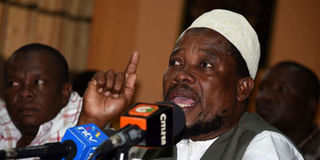Secession talk major headache for Uhuru’s second term

Mombasa Republican Council spokesman Rashid Muraja addressing a press conference in Mombasa on October 25, 2017. PHOTO | KEVIN ODIT | NATION MEDIA GROUP
What you need to know:
- The Coast of Kenya has been the bedrock of secessionists ever since the shadowy Mombasa Republican Council emerged in 1999 to ostensibly address political and economic discrimination against the people of the region.
- The current push by Nasa is not the first and Kenya has tackled two secession bids before.
As the political tussle between President Uhuru Kenyatta and Nasa leader Raila Odinga fades, the talk of secession appears to be the next headache for the country.
The opposition has threatened to call for “self-determination” if dialogue on electoral justice is not initiated. On the other hand, President Kenyatta has said he is not ready to discuss politics and that the campaign season is over.
In their statement after they called off the swearing-in of Mr Odinga and Mr Kalonzo Musyoka as “president and vice-president of the Republic of Kenya” in Mombasa, Nasa said “there are only two options (on the table): Democracy or self-determination.”
This seems to have sent shock waves within the government and when President Kenyatta visited the Coast this week, he warned the secessionist that if they cross the line they will be dealt with. Mr Kenyatta also warned that the government will not “entertain any language (or) any action that threatens territorial integrity.”
DISCRIMINATION
The Coast of Kenya has been the bedrock of secessionists ever since the shadowy Mombasa Republican Council (MRC) emerged in 1999 to ostensibly address political and economic discrimination against the people of the region.
MRC had revived the separatists ghosts of 1962 when an Arab-backed party, Mwambao United Front, emerged in 1962 to agitate for an independent self-governing 10-mile coastal strip which was also to become part of Zanzibar.
The current push by Nasa is not the first and Kenya has tackled two secession bids before. The first was the opposition to the inclusion of the 10-mile coastal strip into Independent Kenya and the second was the attempt by the Somali population in former Northern Frontier District (NFD) to join the greater Somalia in 1963.
For starters, the coastal strip was once part of the Sultanate of Zanzibar and was administered as a British protectorate while the interior was a colony. This was the reason why Kenya, until independence, was known as the Colony and Protectorate of Kenya because it combined both.
REJECTED
At the dawn of independence, the Arabs at the Coast started agitating to join Zanzibar or create their own Mwambao but President Jomo Kenyatta managed to lead his Kanu team in declaring that no part of Kenya would secede. He got the support of Sir James Robertson, the UK diplomat at the time.
The quest for a Mwambao State was rejected at the Lancaster Conference by the indigenous coastal residents who were opposed to another domination by the Arabs.
At the moment, the push for self-determination at the Coast is being led by Mombasa governor Ali Hassan Joho and his Kilifi counterpart, Mr Amason Kingi. But this push has also aroused some diplomatic engagements with the British High Commissioner to Kenya, Nic Hailey, the European Union ambassador, Stefano Dejak, Denmark’s Mette Knudsen, and the French ambassador, Antoine Sivan, recently flying to Mombasa for a five-hour meeting with the two governors. Their message was that “Kenya must remain united” – meaning that the quest for self-determination may not enjoy political support from Western democracies.
LOCAL INTERESTS
The matter is also stirring other local interests and this week, both Mr Joho and Mr Kingi received petitions from Mt Kenya Region Community Association, which is made up of investors, telling both that “the water frontage of the Indian Ocean belongs to 40 million Kenyans.”
In the letter, also addressed to the Office of the President, the group says that the former 10-mile coastal strip was negotiated by Kenyans for Kenya and that it is illegal for Coast politicians to demand it.
“We suggest that the government of Kenya gazettes 30 kilometres in land from the shores of the ocean to belong to... 40 million Kenyans,” said the group.
While that letter brings back the historical aspect of the former territory that was under the Sultan, it also reveals the deep anxiety that the secession talk is triggering among the various communities.
DIVISIVE
Mr Najib Balala, the Cabinet Secretary for Tourism — who hails from the Coast — has termed the self-determination and secession calls as unwarranted.
“They are usually long drawn, bloody and divisive,” he recently said of secession.
While the debate has its ringleaders in the Coast, it has yet to pick up in other Nasa strongholds of former Western, Nyanza and lower Eastern provinces.
The matter was first raised by Nasa’s consultant, Dr David Ndii, who termed Kenya as a “cruel marriage” and called for divorce.
While no political rallies have been called to drum up support for the secession campaign, such a move would create more political heat in an already politically strained. This is what perhaps informed President Kenyatta’s warning this week.
Mr Kamau is the Special Projects Editor. [email protected] @johnkamau1




